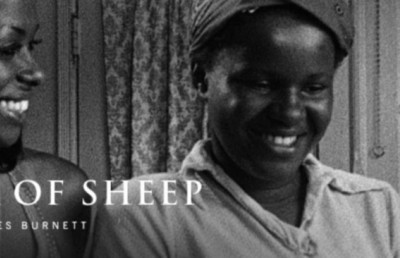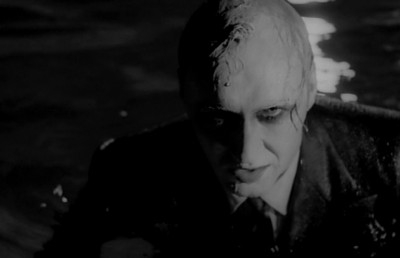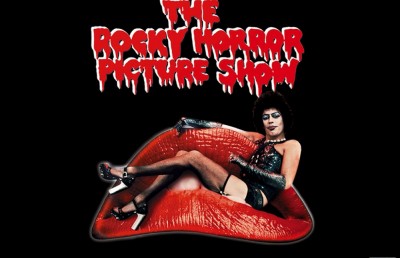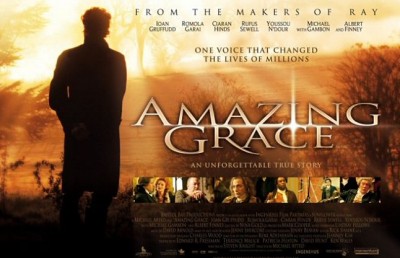The Creeping Flesh
Containing 'Evil'
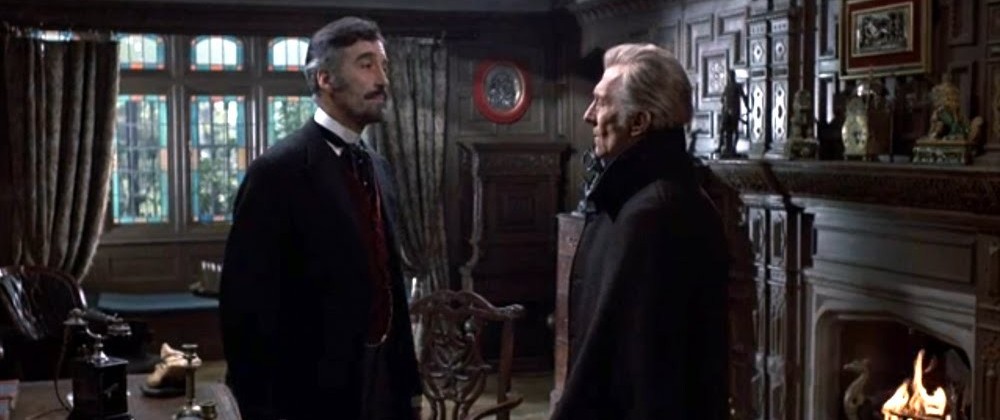
The recent death of Freddie Francis (on March 17, 2007) at the age of 89 signaled the loss of one of Britain’s premier cinematic artisans and one of the last remaining icons of the great Hammer Films studio. Francis began his career way back in 1943 as a camera operator on The New Lot before graduating to cinematographer, where he quickly rose to the top of his field working on Sons and Lovers (Jack Cardiff, 1960) and Saturday Night and Sunday Morning (Karl Reisz, 1960, the former being awarded with an Academy Award). Francis then reached his pinnacle with Jack Clayton’s The Innocents (1961), one of the most ravishing black and white, cinemascope films ever made. The adaptation of Henry James’ Turn of the Screw remains one of the most effective horror films to place ambiguity above resolution. In more precise terms, placing the decision of whether or not the story’s ghosts are real or imagined by the central character –a sexually repressed governess played by Deborah Kerr– in the mind of the viewer. Francis’ wistful cinematography, from the baroque lighting to the precise framing, played a large role in creating the film’s brilliantly gothic atmosphere. After The Innocents he teamed up one more time with Karl Reisz for Night Must Fall (1964), an interesting study of a psychotic killer played by Albert Finney, before taking a 16 year hiatus from cinematography to direct.
Over that next decade-and-a-half Francis established himself as a formidable presence on the International horror scene, always doing a serviceable job, and at times rising well above the mark, as with Paranoiac (1963), Nightmare (1964), The Evil of Frankenstein (1964), and The Skull (1966). Francis was also one of the genuine auteurs of the popular omnibus horror film form, which featured several stories held together by a wrap-around framing device. The model for this form, and arguably still best, was Dead of Night (1956), but Francis made some of the best films of this type: Dr. Terror’s House of Horrors (1965), Torture Garden (1967), Tales from the Crypt (1972), Asylum (1972), and Tales That witness Madness (1973). Although there were some disappointments and, shall we say, interesting failures along the way (Legend of the Werewolf, Trog, Dracula Has Risen From the Grave, Son of Dracula, Vampire Happening), Francis staked his claim as an important figure in the British horror canon. After his fine, literate rendition of the Burke and Hare story, The Doctor and the Devils (1985), he devoted himself once again to cinematography, returning to the art in great form with David Lynch’s The Elephant Man (1980), which was the first films in fifteen years to use black and white and the anamorphic format. Given the setting of Victorian England, the black and white cinematography, and the mild horror film elements in The Elephant Man, it was an appropriate return. Francis made two other films with Lynch, Dune (1984) and The Straight Story (1999). Other highlights of his cinematographic career include Edward Zwick’s Glory (1989) and Martin Scorsese’s Cape Fear (1991).
As an homage to Freddie Francis I would like to analyze one of his more interesting films as a director, The Creeping Flesh (1972). The Creeping Flesh stars Hammer icons Peter Cushing and Christopher Lee as half-brothers Emmanuel and James Hildern. Emmanuel (Cushing) is a scientist who has returned from New Guinea with the skeletal remains of an ancient creature. Although it is never stated, the creature, which goes by the name of Shish Kang (“Evil One”), may be extraterrestrial. While washing the skeleton with water he discovers that moisture causes the skeleton to regenerate itself –hence the film’s title– as flesh magically reappears on the skeletal figure (achieved with stop motion animation). Emmanuel chisels off the now living finger and takes a blood sample to study its cell structure in his quest to prove his theory that evil is a living organism –embodied in the creature– and that this evil can be spread like a contagion. He comes up with an antidote serum for this evil, which he first tries on an ape; because Emmanuel fears that his daughter Penelope (Lorna Heilbron) is in jeopardy of falling prey to the same hereditary mental psychosis as his wife, who recently passed away in James’ mental institute, he injects his daughter with the serum. Unfortunately he was too premature with his lab study and later that night the ape escapes its cage in a manic fit and is found dead on the laboratory floor. Penelope begins to show a personality change from her quiet, kind demeanor to an aggressive siren who frequents the same pubs her mother did (seen in a flashback). At first his half-brother James Hildern, who is also conducting research on the causes of mental illness at his institute for the mentally ill, is unaware of the precise nature of Emmanuel’s biological research into evil; however, when Emmanuel’s daughter is arrested after slashing a man’s throat and brought to his institute he becomes more curious about the research which he has been funding. He brings Penelope back to Emmanuel’s house, where he learns that his brother has experimented on his daughter. He threatens to expose this information if he does not reveal his research findings. While Emmanuel leaves to investigate the off screen sound of his daughter screaming, James steals his brother’s research notes. Later than night he enlists a criminal to steal the skeletal remains of the alien creature so he can lay claim to a prestigious medical award, the Richter prize, that both he and Emmanuel are competing for (James with his manuscript, “The Cause and Prevention of Mental Disorders,” and Emmanuel for what James refers to as his “lunatic theories” about the origins of man.) James is not aware of the effect water has on the skeleton, hence does not take any measure against the rain on the night he steals the skeleton. An accident causes his carriage to capsize. The rain water brings the creature back to life, kills the coach driver, and makes its way back to Emmanuel’s home to seek revenge.
The Creeping Flesh was made at the tail end of a productive five year run for producer Tony Tenser at Tigon pictures (the studio ran until 1985). Although the film attempts (unlike most Tigon films) to emulate the feel of a Hammer film, made perhaps obvious with the pairing of Peter Cushing and Christopher Lee, it has as much in common with another film made in the same year starring the same two actors, the Spanish production Horror Express (Eugenio Martin), which also featured a primordial alien being who spreads like an evil contagion. In this case Lee plays the doctor whose travels abroad discover the remnants of an alien frozen in ice. Like in The Creeping Flesh, the alien is transported in a large wooden crate.
One of the more interesting aspects of The Creeping Flesh is the twist in its narrative structure, which only reveals itself at the end. The film opens inside what appears to be Emmanuel’s oddly furnished, white-walled laboratory, where he informs a visitor that he requires an able medical assistant to help him in his research on evil. After Emmanuel explains the basis of this evil he picks up a log book which holds his detailed research notes, and the scene cuts to a flashback over the following dialogue: “Three years ago (February 21st, 1893) I had just returned from New Guinea, where I had been searching for the remains of primitive man. I brought back with me what I thought was the most sensational scientific discovery of the century, the complete skeleton of a primitive man, which would revolutionize our ideas of the origin of our species.” For the final scene of the film we return to this same location, Emmanuel’s laboratory, only now the camera zooms out to reveal that the doctor is in fact in a cell inside his half-brother’s mental asylum. This reveal can be read in one of two ways: as a simple return to point A in the narrative and a resolution to the flashback; or the possibility of reading the bulk of the film as being told from the position of an ‘unreliable’ narrator (the mind of a mentally disturbed patient). This latter option, of course, has the fascinating historical precedent of emulating The Cabinet of Dr. Caligari (Robert Wiene, 1919), which (in its revised version) ends by revealing that the whole story about Dr. Caligari and his somnambulist Cesare was a tall tale told by an inmate under Dr. Caligari’s care. Just like the revelation of a mentally ill subjectivity can be seen as an explanation for that film’s wildly expressionist art design, the latter would explain some of the more incredulous plot points or character behaviour in The Creeping Flesh. However, given the unscrupulous nature of James Hildern, there is also the possibility that he committed his brother as part of his plan to lay claim to his scientific findings. Perhaps Emmanuel was not insane but a victim of James’ ‘evil’ nature.
Emmanuel shows concern about the possibility of that his wife’s mental illness is hereditary, which explains his overly protective nature toward his daughter Penelope. It can also be an indication that the creature is only a smokescreen for his own obsessions, with the contagion of evil substituting for the real fear he has over mental illness. It is also important to note that the reading of mental illness as a form of evil is historically accurate. Many forms of supernatural condition –demon possession, voodoo possession, vampirism, lycanthropy– were caused by as yet unrecognized forms of mental illness. In the time period of the film’s setting, the late 19th century, there were only a dozen or so known forms of mental illness. Setting the film at this point in time, at this important crossroad between ancient and modern medicine with regards the diagnosis and treatment of mental illness, was no doubt a conscious decision on the part of the filmmaker’s (screenwriters Peter Spenceley and Jonathan Rumbold).

The film opens with Emmanuel putting the finishing touches on an oil painting of the creature. The painting foreshadows an important (though ultimately trivial) plot point: the creature is painted with its middle digit missing on one hand. This looks ahead not only to the moment where the doctor cuts off the creature’s middle finger, but the hoary final scene when the camera reveals Emmanuel’s hand missing the same middle digit, ending the film on the rather lame notion that the alien creature has the same zest for vengeance as humans. A very subtle key to the film’s twist ending is given in the opening line of the film, where we hear an off screen voice say, “A gentleman to see you professor.” Any Hammer fan with a good ear would have noticed that the voice is Christopher Lee’s. With the knowledge gained later in the film about Lee’s character, James Hildern, this would be enough for an observant viewer to foretell the twist ending. If we were indeed at Emmanuel’s home it would not be James calling out this information, but his assistant Waterlow (George Benson). Emmanuel tries to impress on the visitor his belief that evil is a contagion, something that can be spread like a plague. The odd, minimalist art design of his laboratory is another subtle clue that all is not what it seems. In fact when I re-watched the film with someone who was seeing it for the first time the person commented on how odd the doctor’s room appeared (I smiled to myself). The dialogue gives yet another clue. After giving the full story to his rather passive guest of this evil which he claims to have unleashed “3000 years ahead of its time,” and to which only he knows the cure, he says, “Some people even think that I am mad.” Another clue about the opening scene’s deceptive nature is that in the flashback we can see that Emmanuel’s laboratory does not have the same bare, minimalist design as in the opening. His walls have a patterned wallpaper, not the blank white walls of the opening.
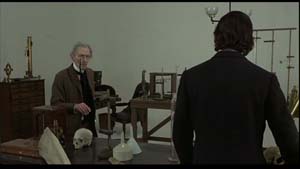
Later in the extended flashback segment that makes up the bulk of the film, there is a longer scene of this exposition, where he recounts the facts to his confused looking assistant Waterlow. According to Emmanuel’s reading of the New Guinea mythology, they believed that their ancestors where a tribe of giants who waged a “titanic battle against good and evil when the world was created” (we can see in this the strong influence of H.P. Lovecraft’s Cthulhu myth of the Ancient Ones, a species of all-powerful aliens who ruled the earth long before humans and had the power to keep in check the forces of evil). In this evolutionary lineage, the Evil One was to be dormant for 3000 years, at which point the people of New Guinea would be technologically equipped to battle this great Evil, at which point the rainwater would revive the dormant Evil One for this grand apocalyptic battle. Emmanuel believes he anticipated this process by 3000 years when he washed the creature’s finger. He interprets this to mean that he has the power of God, in that he can control this struggle between good and evil and theoretically wipe out evil from the world and, in his own words, “have a new paradise on earth.” This scene is a formulation of the classic theme of the ‘overachiever’ who treads in the heretical domain of God –and must suffer the consequences. This theme is common to the science fiction film, but also the titanic Biblical battle of good vs. evil which can be traced from as early as Tod Browning’s 1930 Dracula (Helsing vs. Dracula) on through the Gothic Hammer films pitting Cushing’s Van Helsing against Lee’s evil Dracula. In this scene Cushing’s acting is excellent, managing to moderate between an scientist excited at the prospects of his research and an insane overachiever.
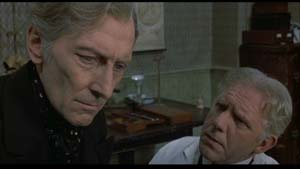
His central idea, which appears ludicrous, is to inoculate humans against the contagion of evil by giving a person a tiny dose of the evil virus, which will act to immunize them against contracting the evil contagion. He then prepares a serum taken from the ‘evil cells’ (from the creatures’ finger) and then tries the serum on a lab ape, and then on his daughter. As throughout, the use of parallel and crosscut editing is essential to underscoring the film’s resonant thematic meaning. This scene of Emmanuel conducting his cell research is intercut with his daughter Penelope’s discover of the lie she has been living with concerning her mother. To protect her from the knowledge of her mother’s mental illness and her sordid history as a promiscuous Folies Bergère dancer, Emmanuel has told Penelope that her mother died when she was very young. To keep this lie a secret Emmanuel has forbidden Penelope from ever entering her mother’s room, which is kept locked. After secretly lifting the keys from Waterlow she enters her mother’s room, which has been left untouched from when mother, Marguerite, lived there. [1] From the articles in the room (clothes, photos, posters), Emmanuel is able to deduce that her mother was a Folies Bergère dancer. Penelope discovers the full truth about her mother when she reads a letter sent to Emmanuel by James and a newspaper article with the headline, ‘famous dancer committed to a mental institute.’ Intercutting this scene with that of Emmanuel’s experiment is important because it creates a parallel between Emmanuel’s antidote and the psychological pressures of Penelope’s discovery of her mother’s past. It is only after both these events –Penelope receiving the serum and learning about her mother’s mental illness– that she begins to show signs of ‘evil.’ Hence there is the possibility of reading her personality change as being caused by this new knowledge rather than the serum (or a combination of both). Indirectly, this also relates to James’ research on the causes of mental illness which, in this case, can be environmental (Penelope discovering the knowledge about her past roots) as well as biological (hereditary).
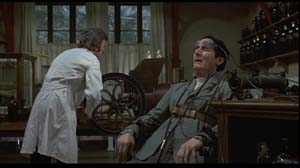
A sense of the historical treatment of mental illness is briefly alluded to in a scene which establishes James’ cruel and evil (in the secular sense) nature. The scene in question catches a glimpse of James’ laboratory as a mental patient is being given a form of early shock therapy as part of James’ experiments in his electronic wave theory. His assistant tells James: “Until you can artificially cause insanity, your theory will prove nothing.” He replies, “Well, unfortunately, in the state of society which exists today we are not permitted to experiment in human beings….normal human beings.” The possible implication is that, if given the chance, he would experiment on ‘sane’ people. Which leaves open the possibility that perhaps Emmanuel is not mentally ill but a victim of James’ opportunism.
“She was a prisoner, like me….you want everybody to be a prisoner….” (Penelope to her father Emmanuel)
One of the over riding themes of The Creeping Flesh is imprisonment. The film evokes images of physical containment throughout its mise en scène, but what is interesting is the way they alternate between forms of imprisonment which function primarily for drama and others that harbor possible social commentary. In almost every case the person (or animal) being imprisoned escapes their physical containment. Hence the theme becomes one of imprisonment/escape (when it functions for dramatic purpose), or repression/liberation (when it harbors social commentary).
The theme of imprisonment is represented right from the very first images of the film: Emmanuel’s painting of the as yet unknown creature. The creature is contained within the borders of the canvas, but symbolically the painting could also represent Emmanuel’s consciousness and the idea that the creature is a product of his imagination. Once into the flashback we see the skeleton being transported in a large crate, out of which the creature will be taken and placed onto the laboratory table. The next images of containment are the ape held in Emmanuel’s laboratory cages. The ape will also escape from the cage after receiving the serum. Emmanuel’s daughter, Penelope is as much a prisoner in her home as the ape, held captive by her passive-aggressive, overly protective (if well-meaning) father, who even prohibits her from reading escapist ‘romance’ stories, from mentioning her mother’s name or entering her room. Emmanuel even acknowledges this in his talk with Penelope: “Perhaps you’ve spent too much time alone in this house. Now that I’m back you’ll be able to go out again, the two of us together, just after I’ve completed my present work.” And yet Penelope ‘escapes’ the confines of the four walls only after being injected with the antidote which seems to release her “Mr. Hyde” side. Hence the evil that Emmanuel claims will spread if not held in check also acts as a liberating agent. Based on his conversation with Penelope the viewer gathers that her mother is dead. But a letter he reads to himself in front of his daughter reveals otherwise. In the voice of his half-brother James, the letter writes, “I unhappily write to inform you that your wife passed away this morning.” So the theme of imprisonment stretches to include his wife, who has been living in a mental institute until her recent death, unbeknownst to her daughter. The viewer need only stretch all of this plot info to surmise that Emmanuel probably contained his wife in much the same manner as he is doing with his daughter (or at least tried to). Emmanuel even keeps his wife’s spirit ‘captive’ by making her bedroom off limits to everyone.

The confining nature of their married relationship is hinted at in the one flashback we see of his wife Marguerite (a flashback within a flashback). Of course given the subjective nature of the film’s framing device, one must remains open to the possibility that the representation of Marguerite may be embellished by his imagination, his memory, or his desire. In the flashback we see Marguerite dancing in a striking red dress for her many male admirers. We see her sleeping with other men. When we see Emmanuel visiting Marguerite in her dressing room he appears meek and she is dismissive of his presence. She is made out to be a real harlot who seems to go insane because of her sexual promiscuity (depicted with a smeared lens effect which distorts her face). She is taken away and placed in an asylum (framed behind a cage, like the ape, and like her daughter Penelope at the film’s end). This flashback establishes the back-story out of which grows Emmanuel’s fear that the same will happen to his daughter. Based on his obsessive fear of her turning evil which, based on this flashback and Penelope’s behavior is equated with promiscuity, convinces him to give Penelope the serum. Ironically, she begins to act ‘insane’ (i.e. promiscuous) only after being given the serum (and after seeing her mother’s room).
The theme of imprisonment functions structurally by the constant parallels between the worlds of Emmanuel and James. For example, there is a parallel between Emmanuel’s laboratory ape and James’ mental patients, both of whom are confined in cells. Just as the ape escaped from its cage (and died), one of James’ ‘apes’ (since he is also experimented on), Charles Lenny, also escapes and gets into a wreckage-causing fight at the pub before dying (like the ape). Along with these thematic links are graphic links, like the cut from the pub in a state of shambles after the brawl, to Emmanuel’s laboratory which is in a similar state of disarray as a result of the ape’s escape. Thematically we have two forms of ‘madness’ let loose by, respectively, James and Emmanuel. The two spaces, the bar and the laboratory, are then linked by Penelope, who, possessed by the spirit/memory of her mother, goes from her home to the same pub (which has been cleaned and restored after the brawl in record time!) and begins to act like her (prostitute?) mother, wearing the same red dress and sporting the same hair style. Immediately there is a conflict between the naivety of her Penelope character and her alluring, provocative physical appearance. So much so that the man who approaches her assumes her reticent behaviour to be an act. Once alone in an upstairs bedroom the man tries to force himself on her, which is when Penelope turns wild and scratches his face like a feline. The spirit of her mother takes over and she begins to dance for the patrons –a skill she could not possible possess given her sheltered life. When a sailor tries to grovel over her she breaks a bottle and cuts his neck with it, and then runs out of the pub chased by the townsfolk. She takes refuge in a barn where Lenny is also hiding, symbolically bringing together the two brothers, since they are both ‘products’ of James and Emmanuel. She is apprehended by the police and brought to James’ asylum.

A long sequence which begins a third of the way into the film is another important thematic/structural link between the two brothers, and the theme of confinement/escape. The scene where Emmanuel discovers that moisture causes the skeleton’s middle digit to grow back its flesh is intercut with the scene of his half-brother’s own bizarre experiments on electronic wave theory. This linkage between the two spaces continues with a simple prop: a set of keys. After the escape of mental patient Charles Lenny, James is required to investigate the cells for security. While on his rounds another inmate manages to force open his cage and wrests the key chain from James’s possession. With one inmate already on the loose, James thinks nothing of shooting him dead before he can leave the confined area (the keys remain stuck on the wire door). A few minutes later we cut back to Emmanuel’s home, and a scene where Penelope distracts his father’s assistant long enough to sequester the chain containing the keys to her mother’s locked room. In both scenes the camera lingers on the key chain, establishing yet another connection between the two brothers and their role in the containment/imprisonment of differing sets of characters/beings. A key is also an apt signifier for both imprisonment and escape, since a key can both lock and unlock a door. There are many other images/notions of confinement: the driver caught under the capsized horse carriage; the financial problems which place a psychological stress on Emmanuel because of his reliance on James for the funding of his expeditions; and the many shots of patients locked in their prison-like cells. In nearly every case, the person (or animal) has a moment of release from their confinement. And likewise, the brothers are responsible for the confinement (and in some cases, also the escape).

For a horror film bearing the title “the creeping flesh” it is almost subversive on Francis’ part that the creature only makes a limited appearance in the last ten or so minutes of the film. It is also in these final ten minutes that the type of visual flourishes commonly associated with Francis’ films occur. The scene begins with the establishment of the creature’s escape. Emmanuel arrives at the scene of the horse carriage crash and sees the driver dead and the creature in the woods in the distance in a nicely silhouetted shot of the imposing, cloaked figure. The encroachment of the creature on Emmanuel’s home is by far the most atmospheric and frightening scene in the film. The scene begins inside the home, with the now mad Penelope using her manacles to strangle her nursemaid and escape confinement (yet another instance of confinement/escape). The scene cuts to nighttime exterior of Emmanuel’s home. There is one brilliantly subtle expressionist lighting effect which defies logic. The shot begins with an empty long shot of the front of the house. Seconds into the shot a cast shadow of the off screen creature appears on the front wall of the house. As the creature advances toward the house the shadow becomes larger and larger. The effect is startling, partly because it defies logic. Based on the physics of lighting, when a figure moves forward toward an object the cast shadow should get smaller not larger. The illogical gesture can once again be explained by the subjectivity factor, or as a manifestation of the supernatural.

In a fitting gesture which finalizes the thematic links between imprisonment/escape, repression/liberation, the past/the present, Penelope is the one who lets ‘evil’ into the house by opening the front door. Francis does a clever thing here by building up the creature’s imposing physical height and fearsomeness by having Penelope shot in a high angle gawking upwards at the off screen creature as it walks passed her. The way the creature enters the foyer and the appearance of Cushing at the top landing of the staircase is staged like the mummy’s arrival at Cushing’s home in the 1960 Hammer film The Mummy. Like Dr. Frankenstein, Emmanuel is forced to confront his creature. Emmanuel locks himself in his room as the creature, filmed from behind, makes his way slowly up the stairs to his bedroom. The creature knocks on the door with the hand missing a middle finger. Although quivering and visibly frightened, Emmanuel feels compelled to unlock his door. We finally get the long awaited revelation of the creature’s face, in a brief close-up. Francis then cuts quickly to a subjective point of view shot of Emmanuel with his hands raised cowering back away from the creature, filmed through the creature’s empty eye sockets. As noted by Bruce Lanier Wright, this odd point of view shot taken from inside the creatures skull is a lift from a similar shot from Francis’ earlier film The Skull. [2] What’s interesting is precisely what we/the creature see through the two eye sockets: Emmanuel through the left eye socket and a portrait photo of Emmanuel’s wife Marguerite through the right eye socket. As the creature’s hand reaches toward Emmanuel he instinctively reaches for Marguerite’s portrait. The scene cuts to a close-up of his hand clutching the portrait. The creature’s four-fingered hand enters the shot and clasps Emmanuel’s hand, then the shot cuts to a close-up of Emmanuel flinching in pain as we hear the crunching off screen sound of his finger being severed. By making the connection between the finger amputation and the image of his wife so obvious, the amputation becomes on an obvious castration symbol. The meek manner in which Emmanuel behaves toward Marguerite in their only brief scene together in the flashback within a flashback, and the way she disregards his appeal for affection and then is seen sleeping with other men suggests the image of a weak, emasculated man. At this point one can read the creature strictly as a product of Emmanuel’s mind, which seems plausible given the framing structure, and the precise framing counter pointing these two figures accords this fleeting appearance of the creature the function of Emmanuel’s ‘avenging conscience,’ coming for retribution, not for the missing finger, but for indirectly causing the psychological breakdown of two women, Marguerite and Penelope.
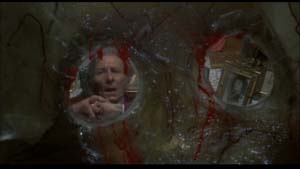
The scene concludes with James arriving on the scene. He sees Penelope in her nightgown dancing madly in the dark exterior of the front garden. He enters the house and sees Emmanuel’s assistant lying dead on the floor. He follows the sound of weeping up to the second floor and enters Emmanuel’s room to find him seated at his desk crying, holding the photo of his wife in his hand. Perhaps tellingly, the creature is nowhere to be found. James walks toward him. His eyes pan tellingly from the photo to Emmanuel, his eyebrows arching as if he were hatching a plot in his mind. This brings an end to the flashback, as the scene dissolves back to Emmanuel in the location seen at the start of the film. Emmanuel continues with his harried appeal for help to stop the creature from spreading its ‘plague of evil’. Emmanuel urges onward with another plea: “You are not going to help me?” The man who we may have thought of as a friend or visitor replies, as he puts on his white frock: “We are helping you Professor. That is what we are here for.” The camera now dramatically zooms out as the doctor shuts a prison-like cell door, framing the doctor on the outside and Emmanuel through the door’s bars. The doctor meets with James, and confirms “he is completely insane,” as they walk side by side. The visiting doctor tells James that the patient’s delusions included thinking they were half-brothers, which James explains as a common thought process for the mentally ill who see him as an authority figure. As they pass by another cell James adds, “He even thinks this woman –as a disheveled, dirty, mad-looking Penelope jumps into view behind the bars– is his daughter.” When asked how long he has been in his custody James replies, “Oh, three years I think. Yes, the year I won the Richter prize.” While James utters his last words: “Hopeless case, I’m afraid,” the camera zooms out and swish pans back to a feeble, grey-haired Emmanuel, muttering “Help me,” as he drops to his feet and the camera tilts down to reveal the missing finger. The camera zooms in to a CU of the hand with the middle finger missing (just in case anyone missed the obvious). The film ends on this freeze frame.
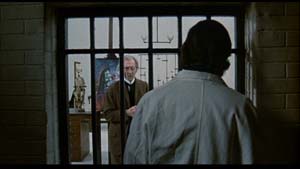
Although The Creeping Flesh is unevenly paced in moments and contains a sometimes maligned plot, a close analysis reveals a film marked by an interesting use of parallel montage, subtle thematic meaning imparted in the mise en scène, and a possible social message submerged within the slightly ludicrous apocalyptic scenario, dealing with the suppression of women in Victorian England (it would be too much of a stretch to read this as feminist). As an aside, the bare bones DVD release of the film by Columbia Pictures is a welcome presentation of a film long available only on a poor, cropped video copy. This restores the film to its proper 1.85 framing, and is a stunning, anamorphic transfer with excellent image clarity and color rendition.
Endnotes
1 Hammer fans are well aware of the effect that the death in 1971 of Cushing’s long time beloved wife Helen had on him. For those who knew him he was never the same after the death of his wife, as if some part of him had been taken away with her. The Creeping Flesh was made about year after her death, which adds some additional resonance to the scenes dealing with Emmanuel and the memory of his wife Marguerite.
2 Nightmare: Gothic Horror Movies. Taylor Publishing; Dallas, Texas, 1995, 136.



